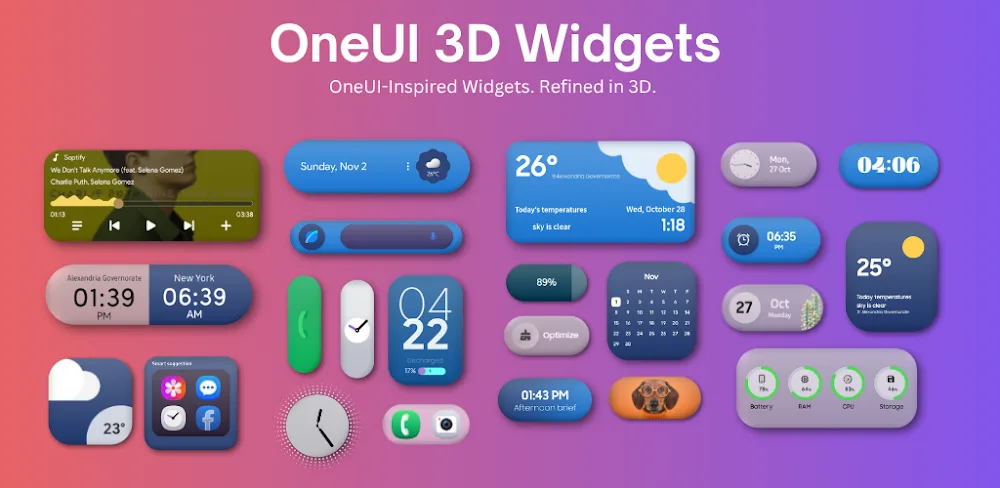OneUI 3D Widgets Mod Apk v.1.0 (Full Version)

- App Name OneUI 3D Widgets
- Version 1.0
- Sizes 60M
- Developer AppixoStudio
- Genre Personalization
- Updated Nov 22, 2025

“`html
In an era defined by rapid technological advancements, mobile applications have become indispensable tools for communication, entertainment, and productivity. The accessibility and convenience they offer have transformed daily life, making the development and deployment of efficient and user-friendly apps more crucial than ever. This article delves into the multifaceted world of mobile application optimization, exploring strategies, techniques, and emerging trends that are shaping the future of app development and user experience. It also examines the implications of these advancements for businesses and individual users alike.
Understanding Mobile App Performance Metrics
Mobile app performance hinges on a variety of key metrics, each providing valuable insights into user experience and overall app health. Among the most important are app loading time, crash rate, and resource consumption. Slow loading times can lead to user frustration and abandonment, while frequent crashes can severely damage an app’s reputation. Monitoring these metrics is essential for identifying potential problems and implementing effective solutions. For example, if an app exhibits high CPU usage, developers may need to optimize code or reduce the number of background processes. Furthermore, memory management plays a crucial role in preventing crashes and ensuring smooth operation, especially on devices with limited resources. Comprehensive performance monitoring requires a combination of automated tools and user feedback. Analyzing user reviews and app store ratings can provide valuable qualitative data that complements quantitative metrics.
Effective app performance also depends on optimizing network requests. Minimizing the number of requests and reducing the size of data transferred can significantly improve loading times. Caching frequently accessed data locally can further enhance performance by reducing reliance on network connectivity. Another crucial aspect is battery efficiency. Apps that drain battery quickly are likely to be uninstalled. Developers should therefore strive to minimize battery consumption by optimizing background processes and reducing the frequency of location updates. Performance monitoring tools such as Firebase Performance Monitoring and New Relic offer real-time insights into app behavior and can help identify performance bottlenecks. By proactively addressing these issues, developers can ensure a positive user experience and increase app retention rates. Learn more about improving user retention strategies here.
Strategies for Enhancing User Engagement
Beyond technical performance, user engagement is a critical factor in the success of any mobile app. User engagement encompasses a variety of elements, including intuitive design, compelling content, and effective communication. Apps with clunky interfaces or irrelevant content are unlikely to retain users. Therefore, developers must prioritize user-centric design principles. This involves conducting thorough user research to understand user needs and preferences. Prototyping and user testing can help identify potential usability issues early in the development process. Furthermore, personalized content and recommendations can significantly increase user engagement by tailoring the app experience to individual users. Push notifications are a powerful tool for re-engaging users, but they must be used judiciously. Overusing push notifications can be intrusive and lead to user frustration. Instead, notifications should be relevant, timely, and provide value to the user.
Gamification elements, such as points, badges, and leaderboards, can also be effective in boosting user engagement. By incorporating game-like mechanics into the app experience, developers can make it more enjoyable and rewarding for users. Social integration is another important aspect of user engagement. Allowing users to connect with friends and share content on social media can increase app visibility and drive user acquisition. However, it is crucial to ensure that social integration is seamless and respects user privacy. A/B testing can be used to optimize different aspects of the app, such as button placement, color schemes, and content layouts. By experimenting with different variations and analyzing user behavior, developers can identify the most effective strategies for maximizing user engagement. Effective engagement is key to long-term app success; understanding various aspects of APKs is important read the full guide on our site.
Mobile App Security Best Practices
In an increasingly interconnected world, mobile app security is paramount. Cyber threats are becoming more sophisticated, and vulnerabilities in mobile apps can expose sensitive user data to malicious actors. Therefore, developers must adopt a proactive approach to security, implementing robust security measures throughout the app development lifecycle. This includes secure coding practices, data encryption, and regular security audits. Data encryption is essential for protecting sensitive data both in transit and at rest. Using strong encryption algorithms and following industry best practices can significantly reduce the risk of data breaches. Secure coding practices involve avoiding common vulnerabilities, such as SQL injection, cross-site scripting, and buffer overflows. Developers should also validate user input to prevent malicious code from being injected into the app. Regular security audits can help identify potential vulnerabilities and ensure that security measures are effective.
Authentication and authorization are critical aspects of mobile app security. Strong authentication mechanisms, such as multi-factor authentication, can help prevent unauthorized access to user accounts. Authorization controls should be implemented to ensure that users only have access to the resources they are authorized to access. Protecting against reverse engineering is another important consideration. Obfuscating code and using anti-tampering techniques can make it more difficult for attackers to analyze the app and identify vulnerabilities. Furthermore, developers should stay informed about the latest security threats and vulnerabilities. Regularly updating the app with security patches is essential for addressing newly discovered vulnerabilities. User education is also important. Educating users about common security threats, such as phishing attacks, can help them protect themselves from fraud. For a closer look at the security aspects of different applications, you might find this post helpful.
Future Trends in Mobile App Development
The mobile app landscape is constantly evolving, driven by technological advancements and changing user expectations. Emerging trends such as artificial intelligence (AI), augmented reality (AR), and the Internet of Things (IoT) are poised to transform the future of mobile app development. AI is already being used in a variety of applications, from personalized recommendations to chatbots. As AI technology continues to advance, we can expect to see even more sophisticated AI-powered features in mobile apps. AR is another exciting trend that has the potential to revolutionize the way we interact with the world. AR apps can overlay digital information onto the real world, creating immersive and engaging experiences.
The IoT is connecting billions of devices to the internet, creating new opportunities for mobile app developers. Mobile apps can be used to control and monitor IoT devices, enabling users to manage their homes, cars, and other devices from their smartphones. Low-code and no-code development platforms are also gaining popularity, making it easier for non-developers to create mobile apps. These platforms provide visual interfaces and drag-and-drop functionality, allowing users to build apps without writing code. 5G technology is poised to further accelerate the growth of mobile apps by providing faster and more reliable internet connectivity. This will enable developers to create more data-intensive and real-time applications. As the mobile app landscape continues to evolve, developers must stay informed about the latest trends and technologies to remain competitive.
Conclusion: Optimizing for Success in the Mobile App Ecosystem
In conclusion, the dynamic mobile app ecosystem demands a multifaceted approach to ensure success. Optimizing app performance through careful monitoring and resource management, enhancing user engagement with personalized content and intuitive design, and prioritizing robust security measures are all critical components. Emerging trends like AI, AR, and IoT offer exciting possibilities for innovation, but also require developers to stay ahead of the curve. By focusing on these key areas, developers can create mobile apps that not only meet user needs but also thrive in an increasingly competitive market. Moving forward, continuous learning, adaptation, and a user-centric mindset will be essential for navigating the ever-changing landscape of mobile app development and achieving long-term success.
“`
- Votes: 1
- Comments: 0







There are no comments yet :(